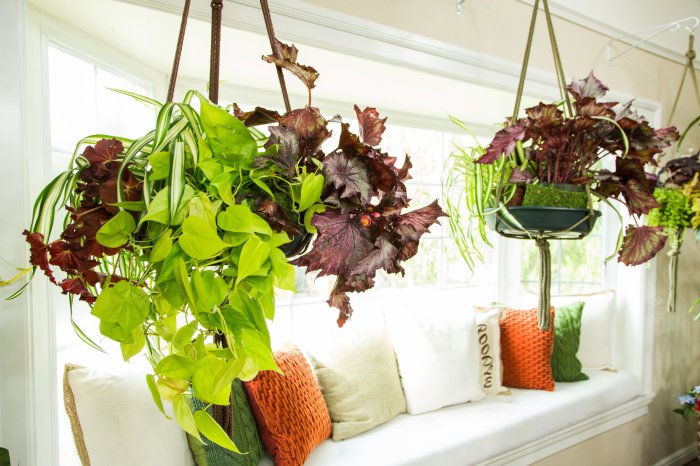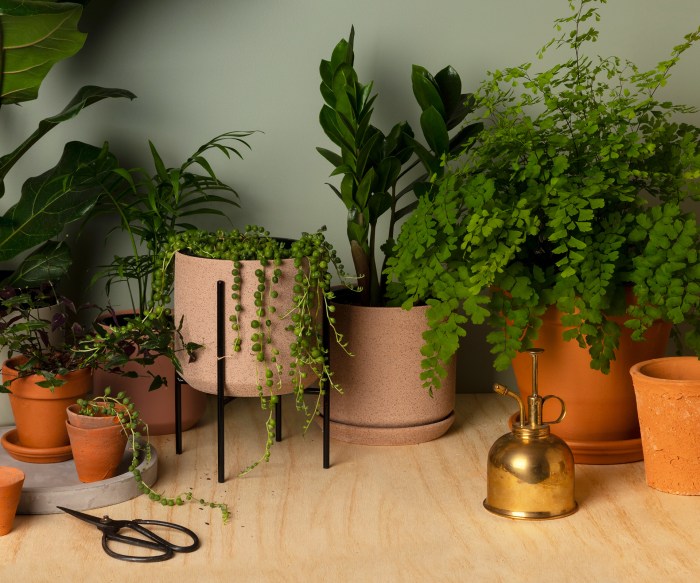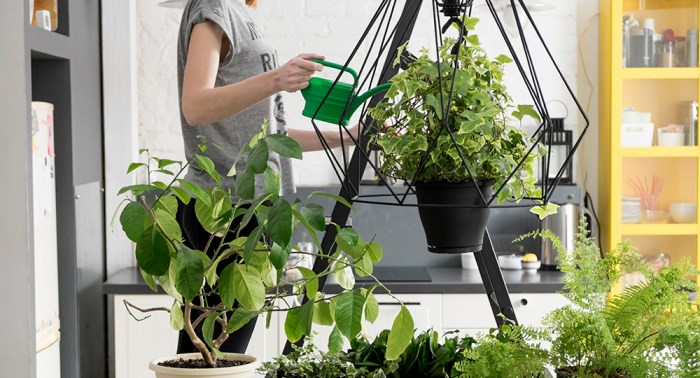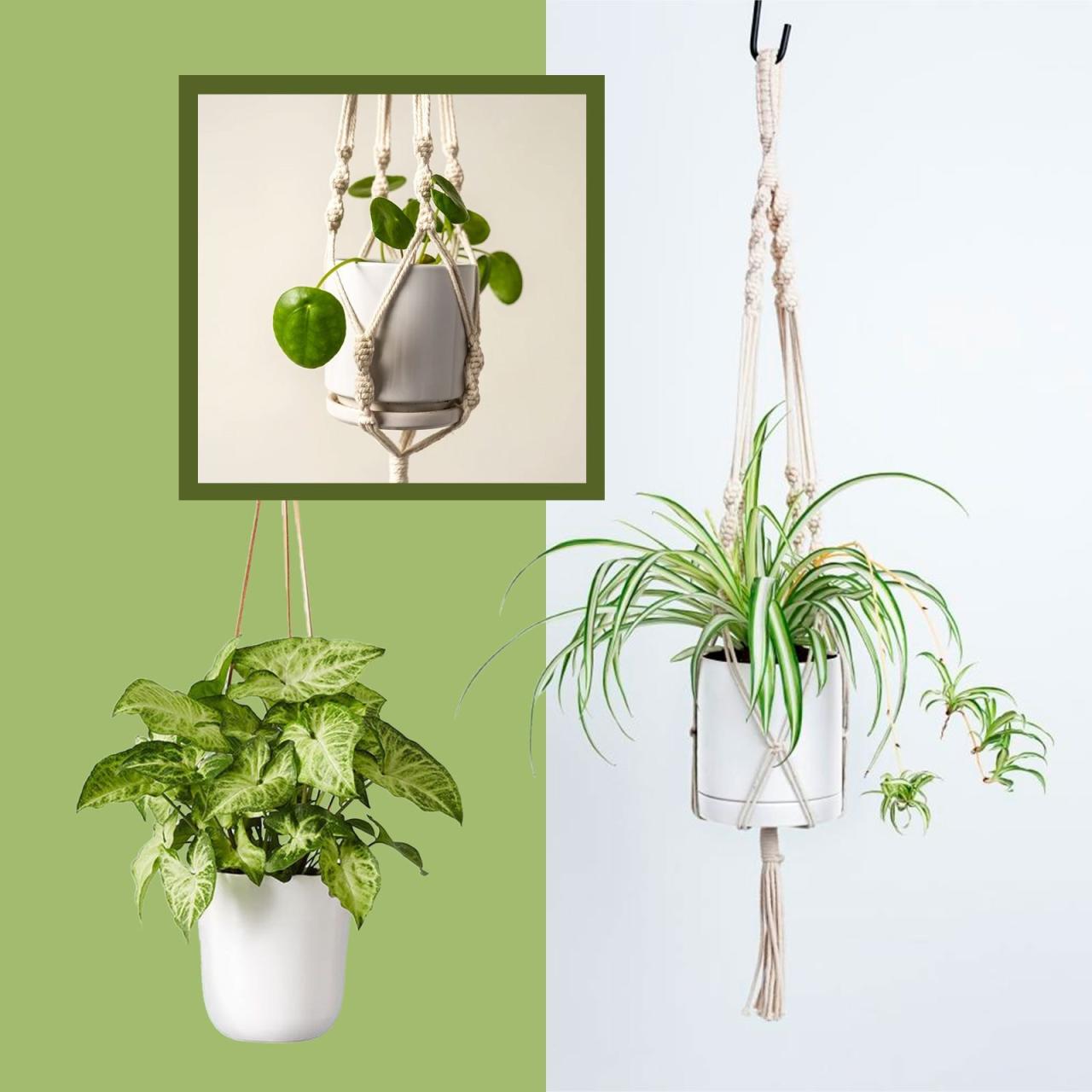Indulge in the captivating world of hanging plants, where nature’s beauty effortlessly enhances your indoor spaces. From lush trailing vines to vibrant foliage, discover the best house plants to hang and elevate your home decor to new heights.
Hanging plants not only add a touch of greenery to your abode but also offer a myriad of benefits. They purify the air, creating a healthier environment, and bring a sense of tranquility, fostering a harmonious atmosphere.
Plant Recommendations for Hanging

Hanging plants are a great way to add life and greenery to any room. They can be used to create a focal point, add height, or simply fill in empty spaces. There are many different types of house plants that are suitable for hanging, each with its own unique characteristics.Some
Among the most popular house plants to hang are those that bring a touch of greenery and life to any space. For those seeking low-maintenance options, best easy hanging plants offer a wide range of choices. From the trailing leaves of pothos to the cascading vines of spider plants, these plants add a touch of elegance and freshness to any home.
of the most popular hanging plants include:
- Spider plant (Chlorophytum comosum): Spider plants are known for their long, trailing leaves that can grow up to 3 feet long. They are easy to care for and can tolerate a variety of light conditions.
- Pothos (Epipremnum aureum): Pothos is another popular hanging plant that is known for its heart-shaped leaves. It is also easy to care for and can tolerate low light conditions.
- String of pearls (Senecio rowleyanus): String of pearls is a unique hanging plant that has long, trailing stems that are covered in small, pearl-like leaves. It is a slow-growing plant that prefers bright, indirect light.
- Burro’s tail (Sedum morganianum): Burro’s tail is a succulent hanging plant that has long, trailing stems that are covered in fleshy, blue-green leaves. It is a drought-tolerant plant that prefers bright, indirect light.
- Air plants (Tillandsia spp.): Air plants are a unique type of hanging plant that does not require soil. They absorb nutrients and moisture from the air through their leaves. Air plants prefer bright, indirect light.
When choosing a hanging plant, it is important to consider the size of the plant, the amount of light it needs, and the type of pot it will be planted in. It is also important to make sure that the plant is securely hung so that it does not fall and cause damage.
Hanging Techniques and Styles

Hanging plants add a touch of greenery and life to any space, but choosing the right hanging technique is essential to ensure the plant’s stability and safety.
There are several popular hanging techniques to consider:
Macrame Hangers, Best house plants to hang
Macrame hangers are a stylish and versatile option that can be customized to fit any plant or décor style. They are typically made of cotton or jute cord and can be knotted in a variety of patterns.
To hang a plant with a macrame hanger, simply loop the hanger around the pot and tie it securely. You can adjust the length of the hanger to suit your needs.
Wall-Mounted Planters
Wall-mounted planters are a great way to save space and create a vertical garden. They come in a variety of shapes and sizes, and can be mounted on any wall.
To hang a plant in a wall-mounted planter, simply insert the pot into the planter and secure it with the provided hardware.
Hanging house plants add a touch of greenery and freshness to any indoor space. From trailing ivy to cascading ferns, there are many beautiful hanging indoor plants to choose from. Whether you’re looking for a plant to add a pop of color to your living room or a way to bring the outdoors in, you’re sure to find the perfect plant for your needs.
For more ideas on beautiful hanging indoor plants, check out this article: Beautiful Hanging Indoor Plants . With so many options available, you’re sure to find the best house plants to hang in your home.
Ceiling Hooks
Ceiling hooks are a simple and inexpensive way to hang plants from the ceiling. They are available in a variety of sizes and styles, and can be screwed into the ceiling or attached with adhesive.
To hang a plant with a ceiling hook, simply attach the hook to the ceiling and then hang the pot from the hook.
When hanging plants, it is important to consider the weight of the plant and the pot. You should also make sure that the hanging method is secure and that the plant will not be knocked over or damaged.
With a little creativity, you can use hanging plants to create a beautiful and unique indoor space.
Hanging plants add a touch of greenery and freshness to any room. For those looking for the best house plants to hang, there are a few options to consider. One popular choice is the trailing ivy, known for its long, cascading vines.
For a more dramatic effect, the string of pearls plant features delicate, bead-like leaves that drape beautifully. Another excellent option is the best draping houseplants , such as the pothos or philodendron, which have large, glossy leaves that create a lush, trailing effect.
These plants are easy to care for and can thrive in various light conditions, making them ideal for any home.
Benefits of Hanging Plants: Best House Plants To Hang
Hanging plants are becoming increasingly popular in homes and offices, and for good reason. They offer a number of benefits, including improved air quality, a touch of nature, and a sense of tranquility.
Studies have shown that hanging plants can help to remove toxins from the air. In one study, researchers found that spider plants were able to remove up to 90% of formaldehyde from the air in a room. Formaldehyde is a known carcinogen that is found in many household products, such as carpets, furniture, and cleaning supplies.
In addition to improving air quality, hanging plants can also add a touch of nature to indoor spaces. This can help to reduce stress and create a more relaxing environment. Studies have shown that spending time in nature can reduce blood pressure, heart rate, and stress levels.
It can also improve mood and boost creativity.
Finally, hanging plants can create a sense of tranquility. The gentle movement of the plants in the breeze can be soothing and calming. This can help to create a more peaceful and relaxing environment in your home or office.
Psychological and Emotional Benefits
- Reduced stress and anxiety
- Improved mood
- Increased creativity
- Enhanced sense of well-being
Hanging plants can have a number of psychological and emotional benefits. Studies have shown that spending time in nature can reduce stress and anxiety levels. It can also improve mood and boost creativity. Additionally, hanging plants can help to create a sense of well-being by providing a sense of connection to the natural world.
Maintenance and Care

Hanging plants require specific care to thrive and maintain their health and appearance. Understanding their watering, fertilizing, and pruning needs is essential for their well-being.
Watering
Hanging plants often have less soil volume than their counterparts in pots, making them more susceptible to drying out. Water regularly, allowing the soil to dry out slightly between waterings. Avoid overwatering, as this can lead to root rot.
Fertilizing
Fertilize hanging plants monthly during the growing season using a balanced liquid fertilizer diluted to half strength. Fertilizing provides essential nutrients for healthy growth and blooming.
Pruning
Prune hanging plants regularly to remove dead or damaged leaves, encourage new growth, and maintain their shape. Use sharp, clean shears to make clean cuts.
Common Problems
- Yellowing leaves:Indicates overwatering or nutrient deficiency.
- Brown tips on leaves:Can be caused by underwatering, low humidity, or fertilizer burn.
- Drooping leaves:May be a sign of underwatering or excessive heat.
By following these care guidelines, you can ensure your hanging plants remain healthy and vibrant, adding beauty and greenery to your home.
Design and Decor Inspiration

Incorporating hanging plants into interior design can elevate the aesthetics of any space. From bohemian abodes to minimalist havens, hanging plants add a touch of nature and create a sense of tranquility.
Hanging plants serve multiple decorative purposes. They can draw attention to specific areas, creating focal points that enhance the overall design. Their lush greenery adds texture and color, bringing vibrancy to any room. Additionally, hanging plants purify the air, contributing to a healthier indoor environment.
Case Studies
- In a bohemian-style living room, macrame hangers suspend trailing pothos plants, creating a whimsical and inviting atmosphere.
- In a modern office, spider plants hang from the ceiling, adding a touch of greenery and reducing stress levels among employees.
- In a public library, large ferns hang from the rafters, creating a sense of calm and serenity while providing privacy between reading areas.
Summary

Incorporating hanging plants into your interior design is an art form. They can transform dull corners into vibrant focal points, add texture and color to minimalist spaces, and create a lush ambiance that invites relaxation and inspiration.
So, embrace the allure of hanging plants and let their verdant charm transform your home into a sanctuary of nature’s beauty.
Questions Often Asked
What are the most popular hanging plants?
Pothos, spider plants, and philodendrons are among the most popular hanging plants due to their hardiness and adaptability.
How often should I water hanging plants?
Water hanging plants when the top inch of soil feels dry to the touch, but avoid overwatering.
Can hanging plants survive in low light?
Some hanging plants, such as snake plants and ZZ plants, can tolerate low light conditions.